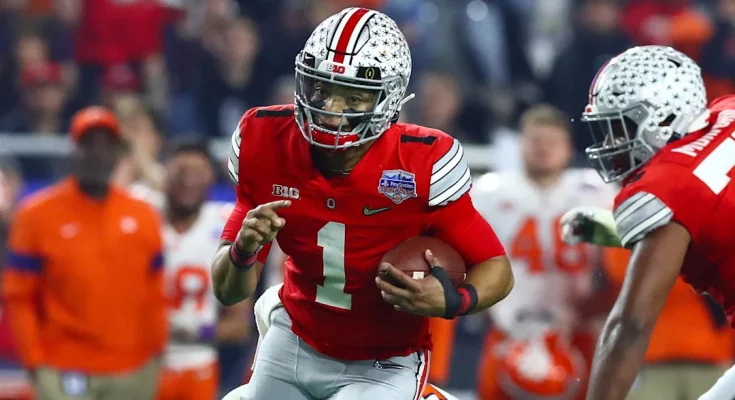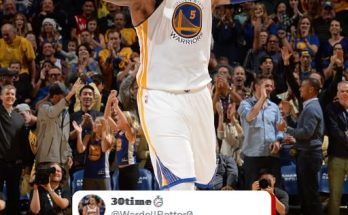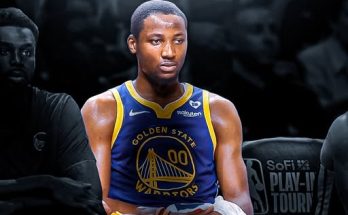When Robert Saleh took the podium at the Jets’ training facility in Florham Park this week, the expectation was routine. Perhaps an update on the offensive line rotation, maybe a few insights into camp battles, or even a passing note about the new rookies adjusting to the NFL. Instead, Saleh delivered something far more impactful — a comprehensive and heartfelt update on a player whose name still sparks fierce debate across college and pro football circles: former Ohio State quarterback and current Jets starter, Justin Fields. In just a few sentences, Saleh managed to shift the tone surrounding Fields’ trajectory in New York, re-centering optimism around a player who many had already started to count out.
Fields, a former top-11 pick in the 2021 NFL Draft, had been dealt from the Chicago Bears in a deal that surprised both franchises and fans. At the time, it was seen as a calculated risk by the Jets — a chance to rebuild the career of a once-dynamic collegiate star who had failed to live up to expectations in Chicago’s dysfunctional offensive system. When he arrived in New York, the message from the Jets was clear: this was not just a flyer or depth piece. They believed in Fields’ upside. They believed in the athleticism, the leadership, and the fire that once made him a Heisman contender and national championship finalist.
That belief, however, was tested in recent weeks as training camp injuries and inconsistent performances in early drills gave rise to doubts. Fields was carted off just days ago after sustaining what initially looked like a serious lower-leg injury. The sight of Fields being taken to the locker room sparked a media frenzy and cast a cloud over what had otherwise been a promising camp. But now, with Saleh’s announcement that the injury was far less severe than feared — just a dislocated toe, with Fields listed day-to-day — the buzz has returned.
According to Saleh, not only is Fields already walking without a boot, but he’s also expected to resume light practice activities before the next preseason game. That’s a stunning development considering the panic that followed the injury. “Justin is a warrior,” Saleh said. “He’s taken every challenge head-on since arriving here, and he’s attacked this setback the same way. He’s locked in, mentally sharper than ever, and we expect him to be back sooner than most would think.” The coach also praised Fields’ attitude behind the scenes, citing his film study, communication with offensive coordinator Nathaniel Hackett, and daily quarterback meetings as indicators of his growth.
This endorsement from Saleh marks a pivotal moment for Fields. The coaching staff isn’t just paying lip service to keep up appearances. From all accounts, Fields is finally in a system that aligns with his strengths. Unlike in Chicago, where questionable play-calling, poor offensive line play, and a revolving door at skill positions derailed his development, Fields is now surrounded by structure. He’s got mentorship in the form of veteran wideout Mike Williams, a strong backfield duo, and a defense capable of keeping the Jets in games — a luxury he rarely enjoyed with the Bears.
Moreover, the Jets have made it clear that the competition at quarterback is wide open. While Fields is currently battling with veteran signal-caller Tyrod Taylor and 2023 draft pick Tim Boyle, there’s a sense around the facility that Fields is gaining ground. Coaches are noticing improvements in his footwork, particularly under pressure. He’s making better reads during red zone simulations, and perhaps most importantly, he’s taking control of the offense with a quiet confidence that echoes his Ohio State days.
It’s easy to forget just how dominant Fields was at the college level. During his tenure with the Buckeyes, Fields threw for 63 touchdowns against just nine interceptions and added 15 rushing scores in two seasons. He led Ohio State to back-to-back College Football Playoff appearances and etched his name into Big Ten lore with a legendary performance against Clemson in the 2020 Sugar Bowl. That version of Fields — poised, explosive, and lethal in the pocket or on the run — is what the Jets are hoping to revive. And according to Saleh’s update, that version might be reemerging sooner than expected.
While Fields has clearly made progress, the Jets’ decision-makers are not rushing anything. Saleh emphasized the importance of patience, both from the media and the fanbase. “We know what he’s capable of,” the coach said. “But this is a process. We’re building him the right way. You don’t just erase three years of turmoil overnight. We’re teaching, he’s learning, and we’re seeing tangible improvement every day.”
Players inside the locker room are also beginning to rally around Fields. Linebacker C.J. Mosley called him “a spark plug” and praised his leadership during team meetings. Rookie receiver Xavier Worthy noted that Fields “throws a beautiful deep ball” and called the quarterback’s work ethic “contagious.” That kind of internal backing can make all the difference in a player’s confidence and chemistry — particularly for a quarterback who has endured as much scrutiny as Fields has over the past two years.
There’s also a broader context to consider. With Aaron Rodgers still recovering from a devastating Achilles tear and his long-term future with the franchise uncertain, the Jets need to solidify a contingency plan at quarterback. Fields, still just 26, offers the kind of athleticism and raw potential that could anchor the position for years if properly nurtured. His mobility adds a dimension that Rodgers never brought to the table, and his arm talent, while inconsistent, has never been in doubt. The question has always been about polish — and for the first time in his professional career, Fields seems to be receiving the development he was denied in Chicago.
Of course, the New York market is notoriously unforgiving. One bad game, one errant throw, one untimely interception can reignite skepticism. But this latest update from Saleh, framed in such clear and deliberate terms, signals that the organization is not just hedging its bets with Fields. They are, in many ways, investing in his future. The dislocated toe may have been a setback, but it also became an opportunity — a rallying point for a team seeking resilience, and for a player seeking redemption.
The next few weeks will be critical. Preseason snaps, even in limited action, could go a long way in shaping perceptions. If Fields can take the field and show the progress the coaching staff has been touting, momentum will continue to build. If not, questions will return. But either way, the fact that Saleh went out of his way to publicly reaffirm his faith in Fields says volumes about where things stand internally.
In a league where quarterbacks often don’t get second chances, especially those who fail to deliver early, Fields’ journey is an outlier. He’s been given a rare opportunity to reset — to prove that the magic he showed at Ohio State wasn’t a mirage. And now, backed by a staff that believes in him and bolstered by a support system that’s nurturing his development, Fields is as close as he’s ever been to turning the corner.
Robert Saleh’s update wasn’t just about medical status — it was a declaration. A message to the rest of the league, to fans, and to Fields himself that the former Buckeye hasn’t just been handed another chance — he’s earned it. What comes next remains to be seen, but one thing is certain: the narrative has changed, and for the first time in a long time, Justin Fields is writing the next chapter on his own terms.



